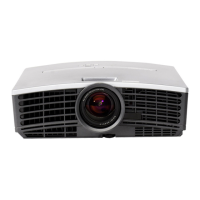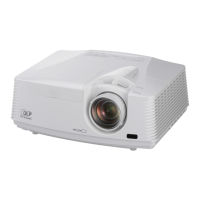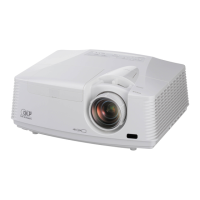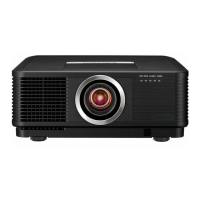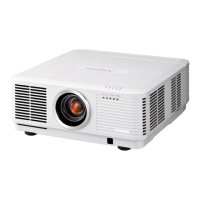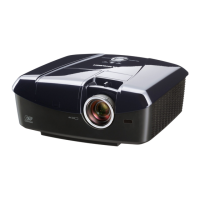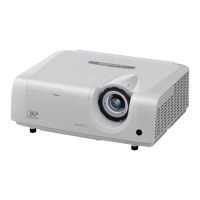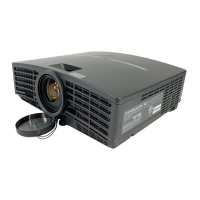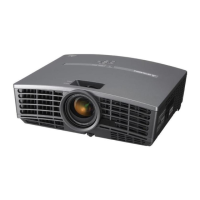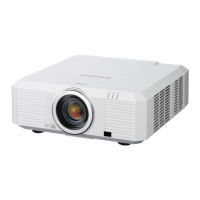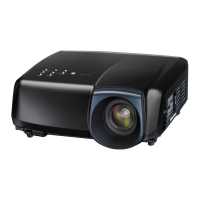Why afterimages persist on Mitsubishi Electric DLP UD740U?
- DdaniellewagnerSep 8, 2025
If you notice afterimages persisting on the screen of your Mitsubishi Electric Projector, this can be improved by continuously projecting an evenly bright image.

Why afterimages persist on Mitsubishi Electric DLP UD740U?
If you notice afterimages persisting on the screen of your Mitsubishi Electric Projector, this can be improved by continuously projecting an evenly bright image.
Why Mitsubishi Electric DLP UD740U power can not be turned on?
If your Mitsubishi Electric Projector's power cannot be turned on, ensure the power cord is correctly connected to both the projector and a working wall outlet. If there are any obstructions blocking the intake or exhaust vents, remove them. Then, unplug the power cord, allow the projector to cool, plug the cord back in, and press the POWER button. Avoid exposing the exhaust vents to heat from other appliances. If the indicator light is steady red, replace the lamp, as it has likely reached the end of its life. Make sure the lamp cover is securely attached. If the issue persists, unplug the power cord and contact your dealer.
Why does my Mitsubishi Electric DLP UD740U Projector power turns off?
If your Mitsubishi Electric Projector turns off unexpectedly, remove any objects blocking the intake and/or exhaust vents. Wait for the fans to stop and the STATUS indicator to go out, then unplug the power cord, wait 10 minutes, plug it back in, and press the POWER button. If the STATUS indicator is steady red, replace the lamp. Ensure that the Auto Power Off setting is disabled. The lamp may also go out if it has deteriorated.
Why does my Mitsubishi Electric DLP UD740U say no signal?
If you are seeing a 'No signal' message on your Mitsubishi Electric Projector, first ensure the connected device is powered on and functioning correctly. Verify that the external device is outputting signals. Check the cable connecting the projector to the external device for any defects and ensure it's connected to the correct terminals. Confirm that the connected device is correctly selected as the input source. If using an extension cord, try replacing it with the supplied cable, and if that works, use an RGB signal amplifier with the extension cord.
Why are Mitsubishi Electric Projector images shaking?
If the projected images from your Mitsubishi Electric Projector are shaking or displaced, check that the cable connected to the external device is not intermittent and connect the cable's plug firmly. For image correction, project an image with many characters and without black areas, then press the AUTO POSITION button. If issues persist, adjust the Signal Detect setting in the Option menu and press the AUTO POSITION button again. If the position and size are still incorrect, use the Signal menu for adjustments.
Why are Mitsubishi Electric DLP UD740U Projector images dark?
If the projected images from your Mitsubishi Electric Projector are dark, adjust the Brightness and Contrast settings in the Picture menu. Note that 3D images may appear darker, which is normal. When viewing 2D images, set the 3D setting in the Picture menu to Auto (for HDMI input only) or Off. If the issue persists, consider replacing the lamp.
What to do if the 3D glasses don’t turn on for Mitsubishi Electric DLP UD740U?
If the 3D glasses don’t turn on when using your Mitsubishi Electric Projector, replace or charge the batteries of the 3D glasses.
Why the menu can’t be used on Mitsubishi Electric DLP UD740U Projector?
If the menu on your Mitsubishi Electric Projector can’t be used, turn off the lamp by pressing the POWER button, unplug the power cord from the wall outlet, wait about 10 minutes, plug the power cord back in, and try again.
What does temperature mean on Mitsubishi Electric Projector?
If your Mitsubishi Electric Projector displays “Temperature!!”, try to eliminate any causes of the rise in ambient temperature and remove any objects blocking the intake or exhaust vents.
What to do if Mitsubishi Electric Projector asks for a password?
If your Mitsubishi Electric Projector displays a screen for entering a password, you should enter the password or contact the person in charge of the projector's management.
| Brand | Mitsubishi Electric |
|---|---|
| Model | DLP UD740U |
| Category | Projector |
| Language | English |
Comprehensive safety guidelines covering operation, maintenance, and handling of the projector.
Guidelines for optimal projector placement regarding temperature, humidity, and surroundings.
Recommendations for maintaining adequate airflow and clearance around the projector.
Notes on altitude limits, avoiding liquids, heavy objects, and vibrations.
Identification of external parts of the projector, including lens, vents, and ports.
Description of buttons and indicators on the projector's control panel for operation.
Details of the various input and output terminals available on the projector.
Detailed description of buttons on the remote control for operating the projector.
Instructions for installing and removing batteries from the remote control.
Information on the effective operating distance and angles for the remote control.
Tables and diagrams to determine screen size and projection distance based on aspect ratios.
Guidelines for mounting the projector on a ceiling, including safety and installation steps.
Instructions for setting up the projector for rear projection.
How to connect analog RGB output devices like VCRs and video cameras.
Instructions for connecting DVD players or HDTV decoders using component video inputs.
Guide to connecting devices with an HDMI terminal for video and audio input.
Connecting computers via mini D-SUB (analog RGB) and discussing DDC standards.
Steps for preparing the projector for initial projection, including power connection and lens cap removal.
Using the LENS SHIFT dial to adjust the projected image position on the screen.
Using the front adjustment feet to tilt the projector for optimal projection angle.
How to use the Auto Keystone function to correct trapezoidal distortion.
Step-by-step guide to powering on the projector, including indicator status and warm-up.
Adjusting image size with the zoom ring and vertical position with the lens shift dial.
Solutions for issues like fine streaks, suggesting screen replacement or focus adjustment.
Procedures for safely powering off the projector, including normal and direct methods.
Using the AUTO POSITION button to automatically align projected images.
Adjusting the speaker volume using the remote control or the audio menu.
Temporarily muting video and audio signals by pressing the AV MUTE button.
Changing the aspect ratio of the input video signal for optimal image display.
Steps to prepare for and view 3D content, including selecting 3D modes and using glasses.
Important health and safety advice for watching 3D content, including precautions for specific individuals.
Adjusts display settings like brightness, contrast, color, and aspect ratio.
Fine-tuning video image properties such as color, sharpness, and tint.
Configures signal input properties like resolution, frequency, and positioning.
Controls audio input selection and speaker volume levels.
Configuration settings related to installation, power modes, and projector orientation.
Customizes projector behavior, including password lock, video signal, and display options.
Manages network connectivity, IP settings, and wireless configurations.
Displays projector status information such as lamp time and input signal details.
Step-by-step instructions for navigating and adjusting settings within the projector's menus.
Detailed explanation of picture settings including Image modes, Brightness, Contrast, and Color Management.
Adjustments for color tone, sharpness, and tint of projected video images.
Configuration of signal input parameters including resolution, frequency, and positioning.
Settings for selecting audio input source and adjusting speaker volume.
Configuration of installation settings, power modes, and projector orientation options.
Customization options including password lock, video signal, and display modes.
Setup and management of network parameters like IP address, SSID, and security settings.
Displays projector status information such as lamp time and input signal details.
Fine-tuning the projected image's brightness and contrast levels for optimal viewing.
Adjusting the color temperature to achieve the desired white balance and tone.
Modifying the color density and tint of the projected image.
Enhancing or softening the projected image's sharpness.
Customizing gamma and BrilliantColor settings for specific image preferences.
Fine-tuning individual color tones (Red, Green, Blue, Cyan, Yellow, Magenta).
Flowchart to diagnose and resolve issues with computer image size, position, and resolution.
Adjusting specific image parameters like tracking, sync, position, and noise reduction.
Methods for precisely aligning the projected image horizontally and vertically on the screen.
Enabling the LPF filter to reduce vertical or horizontal streak noise in projected images.
Setting a custom name for the projector for network identification.
Setting and managing the network password for security and certification.
Configuring DHCP settings to automatically obtain IP addresses or manually set them.
Manually assigning IP addresses, subnet masks, and default gateways for network setup.
Setting the subnet mask and default gateway for network connectivity.
Configuring IP address ranges and the DHCP function for network setup.
Confirming and applying the configured IP settings to the projector.
Configuring wireless network parameters including SSID, channel, and encryption.
Finalizing wireless setup and configuring AMX device discovery.
Resetting network settings to default or restarting the network function.
Projecting computer images via USB, including connection and driver installation.
Steps for starting and ending USB display projection on Windows and Mac OS X.
Projecting images via wired/wireless LAN, supporting remote desktop and tablet control.
Installing the LAN Display System software on Mac computers.
Connecting the projector to a computer using LAN cable or USB wireless adapter.
Choosing the LAN Display input source on the projector or remote control.
Initiating and controlling the LAN display projection using on-screen interface buttons.
Installing necessary drivers for virtual display and audio functions.
Installing Soundflower software for audio transfer on Mac computers.
Connecting a mouse/keyboard to the projector for remote computer operation.
Using SidePad to control the computer from a tablet, including setup and termination.
Transferring files from tablet to projector using WiFi-Doc, including software installation and network setup.
Steps to initiate WiFi-Doc projection by selecting a projector and tapping the icon.
Selecting and projecting files (PtG, AutoRun, Slideshow) using the WiFi-Doc interface.
Procedure to turn off WiFi-Doc on the tablet computer.
Using the projector as a thin client to remotely control a computer via network.
Steps to prepare the host computer for Remote Desktop access, including user accounts.
Setting up user access and configuring Windows Firewall for Remote Desktop connections.
Configuring Windows Firewall exceptions for Remote Desktop access on XP and Vista.
Installing the Thin Client software on the computer for remote operation.
Steps to uninstall the Thin Client software from the computer.
Choosing the LAN Display input source via remote control or projector button.
Connecting the projector to the computer for thin client operation and using the keyboard.
Procedures for disconnecting the thin client session, either with or without ending the session.
Explanation of Client Access Licenses (CAL) required for multi-user access on Windows servers.
Projecting files from USB without a computer, using PtG Converter-Lite for PPT conversion.
Installing the PtG Converter-Lite software for creating PtG files.
Converting PowerPoint files (.ppt) into PtG files for PC Less Presentation.
Selecting the PC Less Presentation input source for projecting files from USB.
Configuring AutoRun, Interval, Repeat, and Sorting options for PC Less Presentation.
Methods for displaying PtG files, AutoRun content, and slideshows from USB.
Procedure for safely disconnecting the USB device after PC Less Presentation.
Enlarging portions of the projected image for detailed viewing.
Temporarily stopping the projected image motion or displaying a still image.
Securing the projector by setting or disabling a password lock.
Controlling and supervising projector operations remotely using computer software.
Connecting and using the PJLink™™ protocol for projector control via LAN.
Reference table of commands for controlling the projector using the PJLink™™ protocol.
Step-by-step guide for replacing the projector lamp, including safety precautions.
How to reset the lamp operation time after replacing the lamp.
Information on recommended lamp replacement intervals and related indicators.
Solutions for problems related to the projector not turning on or turning off unexpectedly.
Troubleshooting steps for when no image is displayed on the screen.
Resolving issues where the password screen appears or 'No signal' is displayed.
Solutions for common image display problems like shaking, distortion, or incorrect brightness.
Solutions for projected images appearing wavy or having incorrect color tint.
Resolving issues with missing motion areas, noise, flickering, or twitching projected images.
Troubleshooting common projector problems like warm air, no audio, menu errors, and indicator lights.
Troubleshooting common problems with the remote control and fan operation during standby.
Resolving issues related to 3D image display, glasses sync, and compatibility.
Checks to perform if the projector fails to turn on or the STATUS indicator blinks after lamp replacement.
Important safety warnings and precautions for performing maintenance on the projector.
Guidelines for cleaning the projector body, vents, and lens using appropriate materials.
Information on using the Kensington Security Standard connector for physical security.
Explanation of POWER and STATUS indicator lights during normal projector operation.
Troubleshooting guide based on abnormal indicator patterns for power, status, and lamp.
Detailed technical specifications of the projector, including performance, connectivity, and physical characteristics.
Detailed pin assignments for all projector input and output connectors.
Diagrams of projector dimensions and a list of items included in the projector package.
Table detailing supported input signals, resolutions, frequencies, and Plug and Play compatibility.
List of 3D signal formats supported by the projector and their terminal compatibility.
Information on Native mode for optimal display and important notes on signal compatibility.
